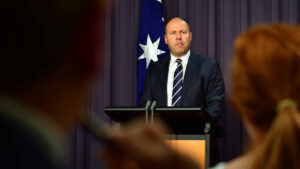Home » Commentary » Opinion » Someone has to pay for Australia’s financial largesse
· Canberra Times

 The government is painting a very rosy picture in its Mid-Year Economic and Fiscal Outlook.
The government is painting a very rosy picture in its Mid-Year Economic and Fiscal Outlook.
It’s not just that the economy has recovered from COVID lockdowns so much better than expected. Inflation will settle in the middle of the RBA’s band. Real GDP growth will be strong for at least two years. Wages will grow faster than pre-pandemic.
Most importantly, unemployment will plunge well below 5%, for “only the second time since the early 1970s”.
The government might be patting themselves on the back for these economic figures, but the contrast between the last time unemployment was at this level, and now, is not flattering for the Coalition.
The 2007-08 budget predicted growth of 3.75%, with unemployment approaching 4%, and inflation and wages also looking quite good. The final budget outcome for the year showed a $20 billion surplus.
When adjusted to current GDP levels this is almost $150 billion better than the predicted deficits over the following two years.
The circumstances are undeniably different — the budgetary impact of the pandemic cannot be ignored — but deficits are now predicted to continue at several percentage points of GDP indefinitely.
This means that, while the spending may have been sold to us as temporary, the spending problems in the budget are now structural. They won’t be solved by the development of new and better vaccines or treatments for COVID.
None of this has arisen as a result of MYEFO. In fact, we shouldn’t misunderstand what MYEFO is, and what it is not. First and foremost, while MYEFO looks like a budget, it’s not. It largely outlines the impact of the economy on the government, rather than impact of the government on the budget.
This means that MYEFO isn’t really a policy document in the normal sense. To the extent that it addresses policy decisions, it is largely an accounting exercise for decisions made since the budget.
But if government wasn’t outlining a new agenda in MYEFO, it sure has been busy since the budget. Government has committed to spend almost an extra $50 billion across the forward estimates, just since the budget. $31 billion is this financial year but that leaves a substantial portion for the next three years, undercutting the narrative that this is all just emergency pandemic spending.
This is a textbook example of how the fiscal environment created by an emergency can so easily lead to structural changes to the budget. The expectation — and temptation — to continue spending is so hard to deny.
In some respects, the government is lucky that the economic circumstances have improved so much that the spending decisions have been outweighed by what MYEFO calls ”parameter and other variations”.
Some economists will claim this isn’t luck but a consequence of Keynesian fiscal stimulus, but the government would be well advised to steer well clear of that debate. As Joe Biden’s $5 trillion ‘Build Back Better’ boondoggle shows, conservative governments will never be able to spend at the same rate as progressive ones.
However, that doesn’t make the decades of deficit projected in MYEFO good public policy.
The government is being criticised — rightfully — for some naked pork-barrelling in its spending priorities in recent years. The opposition, of course, is outraged and promises to do better.
The problem is that this kind of spending is endemic to government. It’s not just that both sides of politics do it; it’s an inevitable response to the incentives of government. Politicians are every bit as motivated by incentives as private industry.
Governments face pressure to reward their supporters, and to give marginal electorates a motivation to vote for them. Those who continue to insist that government should continue to expand and take on greater responsibility have to understand that these incentives will always undermine the efficient allocation of resources.
Maybe we should stop expecting better of our politicians and start limiting their ability to make the same old mistakes.
It is in this context that the $16 billion labelled as “decisions taken but not yet announced” should be accessed. While the quantum is large, this isn’t nearly the big deal it’s being made out to be. In particular the bizarre claims from the opposition that this some kind of ‘secret slush fund’ or represents ‘politically-motivated rorts and waste’ makes no sense at all.
That money may well eventually be wasted — it is government spending, so it’s a good chance — but nothing dodgy has been done by including it in MYEFO.
But in some respects, MYEFO has outlined a potential battleground for the election. Eventually the structural deficit in the budget must be addressed.
Some analysts might believe this reckoning can be deferred indefinitely; but it can’t be. Someone will have to sacrifice, someone will have to pay for this largesse.
Though it may seem incongruous, this debate may well favour the government. The Coalition has no right to claim a mantle of fiscal responsibility — it spent this money in the first place, and continues to produce budget documents with massive deficits.
It has also been in office for most of a decade and is bequeathing a mess to its potential successor.
Yet nothing in Labor’s approach thus far indicates that it will impose the kind of fiscal discipline that its former Finance Minister, Peter Walsh, was once famous for.
In the end, this is yet another disappointing document that its authors are extremely proud of. The Australian economy continues to defy all expectations, suggesting the fundamentals remain extremely sound.
Pity we can’t say the same for our fiscal position.
Someone has to pay for Australia’s financial largesse